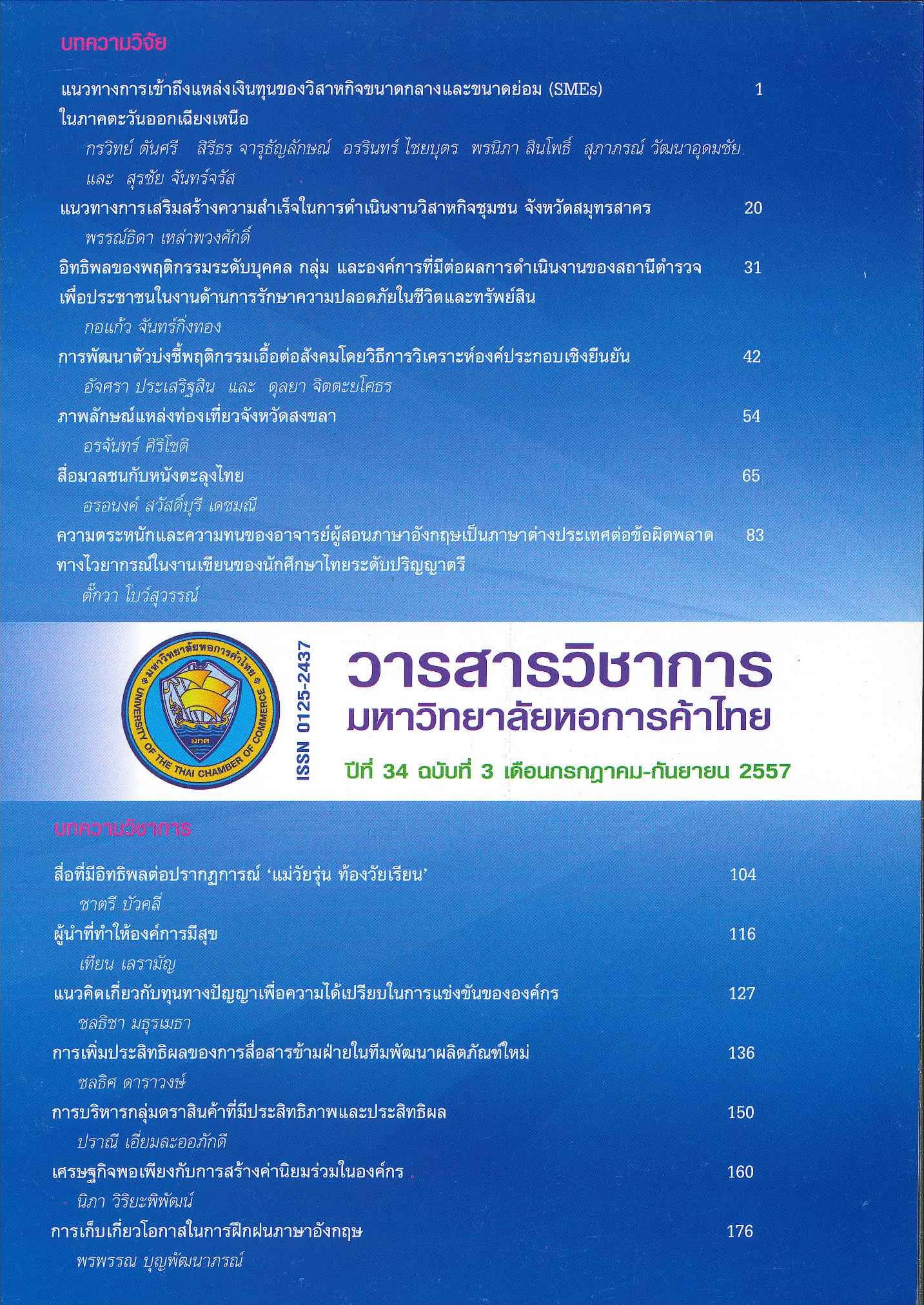The Development of Indicators of Prosocial Behavior by Confirmatory Factor Analysis
Main Article Content
Abstract
The objective of this research was to analyze the confirmatory factor analysis of prosocial behavior. The sample comprised 500 university students in the Bangkok Metropolitan Region. The two-stage sampling technique was applied in the research and data collection was conducted through prosocial behavior questionnaires containing 25 questions. The questions were classified into 5 sub-indicators; each sub-indicator had 5 items. The results of correlation analysis of all 5 factors of prosocial behavior consisting of 1) Giving, 2) Sharing, 3) Helping, 4) Comforting, and 5) Cooperating indicated that correlation coefficients were ranged from 0.341 to 0.634 at .01 significance level. The “Giving” and “Comforting” had the lowest correlation coefficients (r=0.341), whereas “Sharing” and “Helping” had the highest correlation coefficients (r=0.634).The confirmatory factor analysis has the completely standardized solution and reliability between 0.650-0.829, and 0.436-0.688 respectively. The maximum completely standardized solution factor is “Sharing” (0.829), “Helping” (0.762), “Comforting” (0.708), “Giving” (0.660) and “Cooperating” (0.650), respectively. The value of model analysis resulted in x2=4.254, df=3, p=0.024, RMSEA=0.029, RMR=0.013, GFI=0.997, AGFI=0.983, Model AIC = 28.254, Saturated AIC = 30.000, Model CAIC = 90.829, Saturated CAIC = 108.219
Article Details

This work is licensed under a Creative Commons Attribution-NonCommercial-NoDerivatives 4.0 International License.
ลิขสิทธิ์ของบทความ
ผลงานที่ได้รับการตีพิมพ์ถือเป็นลิขสิทธิ์ของมหาวิทยาลัยหอการค้าไทย ห้ามมิให้นำเนื้อหา ทัศนะ หรือข้อคิดเห็นใด ๆ ของผลงานไปทำซ้ำ ดัดแปลง หรือเผยแพร่ ไม่ว่าทั้งหมดหรือบางส่วนโดยไม่ได้รับอนุญาตเป็นลายลักษณ์อักษรจากมหาวิทยาลัยหอการค้าไทยก่อน
References
Bentler, P. M., and Chou, C. 1987. “Practical Issues in Structural Modeling.” Sociological Methods and Research 16, 1: 78-117.
Carlo, G., et al. 2007. “Parenting Styles or Practices? Parenting, Sympathy and Prosocial Behaviors Among Adolescents.” The Journal of Genetic Psychology 168, 2: 147-176.
Chantos, Petchrat. 1999. “A Study of Relationships between Cooperative Behavior and Different Self-Perceived Parent Styles of Prathomsuksa Five and Six Students.” Master’s Thesis, Graduate School, Chulalongkorn University. (in Thai).
เพชรรัตน์ จันทศ. 2542. “การศึกษาความสัมพันธ์ระหว่างพฤติกรรมการให้ความร่วมมือและรูปแบบการอบรมเลี้ยงดูที่แตกต่างกันตามการรับรู้ของตนเองของนักเรียนชั้นประถมศึกษาปีที่ 5 และ 6.” วิทยานิพนธ์ปริญญามหาบัณฑิต สาขาวิชาจิตวิทยาพัฒนาการ จุฬาลงกรณ์มหาวิทยาลัย.
Chitayasothorn, Dulaya. 2013. “The Relationship between Empathy and Prosocial Behavior.” University of Thai Chamber of Commerce Journal 33, 3: 154-171. (in Thai).
ดุลยา จิตตะยโศธร. 2555. “ความสัมพันธ์ระหว่างความร่วมรู้สึกกับพฤติกรรมเอื้อต่อสังคม.” วารสารวิชาการมหาวิทยาลัยหอการค้าไทย 33, 3: 145-162.
Eisenberg, N., et al. 1995. “Prosocial Development in Late Adolescence: A Longitudinal Study.” Child Development 66, 4: 1179-1197.
Eisenberg, N., Fabes, R.A., and Spinrad, T.L. 2006. “Prosocial Development.” In Eisenberg, N. (Ed.), Handbook of Child Psychology: Social, Emotional, and Personality Development 3, pp.646-718. New York: Wiley.
Eisenberg, N., and Miller, P.A. 1987. “The Relation of Empathy of Prosocial and Related Behaviors.” Psychology Bullentin 101, 1: 91-119.
Eisenberg, N., and Shell, R. 1986. “The Relation of Prosocial Moral Judgment and Behavior in Children: The Mediating Role of Cost.” Personality and Social Psychology Bullentin 12: 426-433.
Eisenberg, N., et al. 1987. “Prosocial Development in Middle Childhood: A Longitudinal Study.” Developmental Psychology 24 : 712-718.
Gagne, P., and Hancock, G. R. 2006. “Measurement Model Quality, Sample Size, and Solution Propriety in Confirmatory Factor Models.” Multivariate Behavioral Research 41, 65-83.
Gini, G., et al. 2007. “Does Empathy Predict Adolescents’ Bullying and Defending Behavior?.” Aggressive Behavior 33, 5: 467-476.
Hoffman, M.L. 1981. “Is Altruisum Part of Human Nature?.” Journal of Personality and Social Psychology 40, 1: 121-137.
Kowatrakul, Surang. 2005. Educational Psychology. 6th ed. Bangkok: Chulalongkorn University. (in Thai).
สุรางค์ โค้วตระกูล. 2548. จิตวิทยาการศึกษา. พิมพ์ครั้งที่ 6. กรุงเทพมหานคร: สำนักพิมพ์แห่งจุฬาลงกรณ์มหาวิทยาลัย.
Mussen, P., and Eisenberg, N. 1977. Root of Caring, Sharing and Helping: The Development of Prosocial Behavior in Children. San Francisco: W.H. Freeman.
Padilla – Walker, L.M., et al. 2012. “Bidirectional Relations between Authoritative Parenting and Adolescents’ Prosocial Behaviors.” Journal of Research on Adolescence 22, 3: 400-408.
Perry, D.G., and Bussey, K. 1984. Social Development. Englewood Cliffs, NJ : Prentice – Hall.
The Royal Institute. 2007. Dictionary of Psychology. Bangkok: The Royal Institute. (in Thai).
ราชบัณฑิตสถาน. 2550. พจนานุกรมศัพท์จิตวิทยา. กรุงเทพมหานคร: ราชบัณฑิตสถาน.
Scrimgeour, M.B., et al. 2013. “Cooperative Coparenting Moderates the Association between Parenting Practices and Children’s Prosocial Behavior.” Journal of Family Psychology 27, 3: 506-511.


